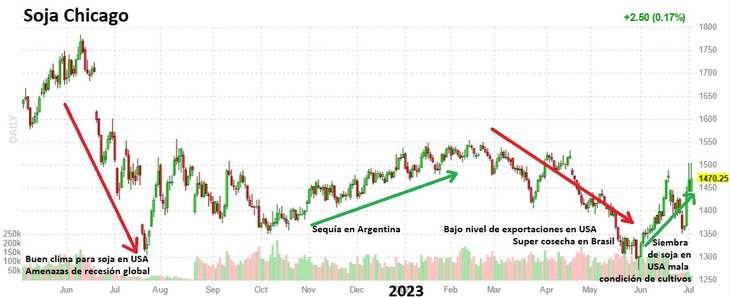July is one of the months in which the grain market, mainly soybeans and corn, shows greater volatility in its prices, Linked to the level of speculation that surrounds the definition of yields of both crops in the Northern Hemisphere, the United States taking almost all eyes for being the great producer and exporter of the north. Interpreting the information and actions that move prices, strengthens criteria for making business decisions.
image.png
In the last 24 years, July has been a month in which the predominant trend in both soybean and corn prices has marked the movement of the rest of the months in almost half of those years, while in the rest, July has taken a direction that was later reversed in the following months, it cannot then be inferred whether July is a month that marks a trend or precedes a change in trend. However, if the idea that important price variations between minimums and maximums occur in July, that is, it has almost always been crossed by high volatility. In the table, it can be seen in colors like a traffic light, the moments of calm and tension in the international corn and soybean markets, and July shares high tension in both.
Where do the prices coming to this July 2023 come from?
It is observed that the international soybean market was affected downwards by good weather during July, which strengthened the idea of a good US harvest, other seasonings such as the conflict between Russia and Ukraine, threat of global recession, level of demand for US soybeans, It made prices come and go, until consolidating increases since November, mainly directed by the drought in Argentina. March and April begin to show downward force, due to poor export performance in the USA and a large harvest in Brazil, added to lower international demand for soybeans.
This is how June is reached, with an accelerated planting of soybeans in the United States, and doubtful weather due to drought, which, despite the large harvest in Brazil, pushes up international prices.
What will happen to the soybean market?
Last week, the United States Department of Agriculture reported that in that country the 22/23 soybean stock as of June 2023, of 21.7 million tons, is 18% lower than the 21/22 soybean stock last year. same date, while the soybean planting area 23/24, of 33.8 million hectares, is 5% lower than the planting area 22/23. Both data are bullish for soybeans, and the market continues to strengthen upwards, until the weather in July, consolidating the idea of rains over the productive region of the United States, cuts the increases, and prices fall again.
image.png

The soybean market is in international moments of great volatility, July will help to make it so, with rain or no rain on the area planted in the United States, and growing conditions. However, demand will depend on South American sales and the global geopolitical context. The increases can be short-term opportunities, which you have to know how to manage by taking hedges in the futures market.
What will happen in the corn market?
The corn market comes from a lot of prominence in the conflict between Russia and Ukraine, which kept corn at good international price levels, despite having a good level of cereal supply in terms of volume harvested in the Northern Hemisphere. The weather in the United States only marked the rises and falls between July and August, once the harvest was assured, there were forces that kept prices at a good level for many months, the conflict between Russia and Ukraine, the drought in Argentina, among the most important, to then fall in April due to the large harvest of safriña maize expected from Brazil.
image.png

Last Friday, the USDA reported a quarterly stock 22/23 of 104.3 million tons, 6% below the corn stock last year at this time, while the planting area 23/24 in the United States is more than 38 million hectares, 6% above planting 22/23 last year. The market takes these data, along with better weather prospects in that country, in addition to the entry of the Brazilian saffron, downwards, and it is observed in the graph, with prices that pierce the lows of last year.
Conclusions:
The weather in July, mainly in the United States, where yield is defined, will show up and down in international prices, and, although there are other seasonings that affect it, the short term will have that force for soybeans and corn. Any increase in the international market, which is reflected in the local market, such as soybeans for the 23/24 harvest, must be considered to cover prices for the new harvest.
While any drop in corn must be considered to stop decisions, and resume indifference prices, which indicate minimum prices necessary to avoid falling into negative margins. The weather in July can provide an opportunity, not for the immediate market, but for the 23/24 harvest, to see it, analyze it and make decisions.
Ing. Agr. msc. Agribusiness. @DeEmilioMarian. INTA The Roses
Source: Ambito
David William is a talented author who has made a name for himself in the world of writing. He is a professional author who writes on a wide range of topics, from general interest to opinion news. David is currently working as a writer at 24 hours worlds where he brings his unique perspective and in-depth research to his articles, making them both informative and engaging.




